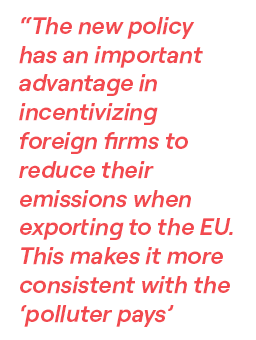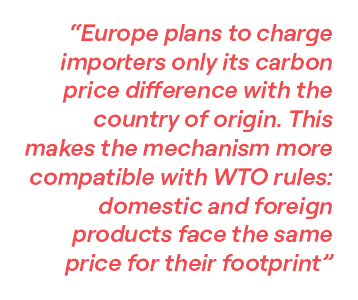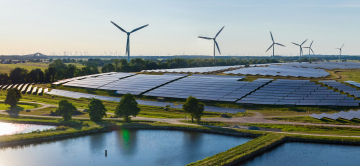How can the EU pursue ambitious net-zero targets without fueling carbon emissions overseas? A new report by Stefan Ambec, Director of TSE Energy & Climate Center, provides an economic analysis of its proposed Carbon Border Adjustment Mechanism (CBAM). Here, he discusses the likely impacts of the policy and some of the challenges that regulators still need to address.

Europe has cut greenhouse gas (GHG) emissions by around 30% since 1990. Which policy tools have been most effective?
In the power and manufacturing sectors, the EU has relied mostly on the Emissions Trading System (ETS). Since 2005, this caps the GHG emissions of the most polluting industries within the EU. To incentivize abatement efforts and respond to climate targets, the cap is being steadily reduced. Participating firms buy allowances through an auction system, or receive them for free if there are exposed to international competition. They trade allowances on the EU ETS market.
Why change?
An emission trading scheme is a powerful and cost-effective policy instrument but it may lead to carbon leakage. This happens when the burden of carbon pricing encourages manufacturers to move carbon-intensive activities abroad, rendering the emission cap ineffective. Worse, the ETS can be counter-productive if European manufactures are replaced with more carbon-intensive products.
The EU CBAM replaces the free allowance policy for selected sectors with a border charge on imports. During a transition period, this charge will be combined with border rebates on exports to countries with a similar carbon price.
 How will the impact of the CBAM compare with the ETS?
How will the impact of the CBAM compare with the ETS?
In my analysis, free allowances level the playing field both within the EU and on international markets by reducing the cost of the ETS for firms. European firms have an incentive to reduce their carbon emissions even if they obtain part of their allowances for free. In contrast, the CBAM levels the playing field only within the EU unless it is complemented with export rebates. However, the CBAM has an important advantage in incentivizing foreign firms to reduce their emissions when exporting to the EU. This makes the CBAM more consistent with the “polluter pays” principle.
Which sectors should the CBAM target?
Only few sectors – aluminum, cement, electricity, fertilizers, iron and steel – are targeted in the EU proposal. While this seems better for administrative feasibility, it can have undesirable effects. First, products in targeted sectors can be replaced by close substitutes that are not part of the CBAM: for instance, by substituting cement and steel by wood or glass in construction. Second, when targeted products increase manufacturing costs, the CBAM might lead to carbon leakage further down the supply chain. For example, car and plane manufacturers might move production abroad to access cheaper steel, electricity, or aluminum.
This leakage could be avoided by covering more products downstream. For instance, by including the weight of CBAM-covered raw materials used to make imported products. However, this would introduce another layer of complexity. Focusing on core energy-intensive and trade-exposed sectors may be more effective.
The EU plans to extend the CBAM to hydrogen, plastic, and organic chemical products. This will add further complexity due to new technologies, highly diverse emission factors, and long value chains.
What scope of emissions should be covered?
Although it has the merit of simplicity, including only direct emissions (Scope 1) underestimates the carbon footprint and generates perverse incentives. For instance, a manufacturing plant can dramatically reduce its product’s footprint by switching from in-house energy to potentially more carbon-intensive grid power. This causes emission leakage to the electricity generation sector, in which emissions are generally not capped outside Europe. In response, the EU parliament has stated that indirect emissions (Scope 2) should be included in the footprint calculation, mirroring the scope of the ETS.
How does the EU account for overseas emissions?
Measuring carbon footprints can be tricky, especially when production occurs outside the EU. Data on emissions at manufacturing plants are not always available or reliable. The product must be tracked along the entire supply chain, potentially in several countries. The EU CBAM mitigates these problems by obliging importers to submit an emission factor verified by an accredited third party. If they do not, a default emission factor is applied.
The product must be tracked along the entire supply chain, potentially in several countries. The EU CBAM mitigates these problems by obliging importers to submit an emission factor verified by an accredited third party. If they do not, a default emission factor is applied.
The EC plans to charge importers only the carbon price difference between the EU and the country of origin. This makes the CBAM more compatible with WTO rules: domestic and foreign products face the same price for their footprint. It also makes climate change mitigation more cost-effective by encouraging global convergence to a unique carbon price. However, calculating the foreign carbon price is not easy as pricing mechanisms vary considerably around the world.
What should be done with CBAM revenues?
The EU proposal requires investing CBAM revenue in decarbonization in developing countries. Meanwhile, the phasing out of free allowances will generate funds from auctioning allowances: this revenue is already assigned to member states, with at least 50% restricted to climate and energy-related purposes. From 2013 to 2015, it was devoted to renewables (29.5%), energy efficiency (28.5%), international climate finance (12.7%) and infrastructure (12.2%). Other options for recycling carbon-pricing revenue include transfers to vulnerable households, investment in low-carbon tech and transport, tax cuts, reduction of public debt, and transitional support to industries.
Would a Climate Club be a better alternative?
To circumvent the challenges of reaching a COP-style agreement involving all countries, Nobel prize winner William Nordhaus has proposed the concept of Climate Club. This would address carbon leakage by building high tariff barriers around a coalition of countries who share a substantial carbon price. To trade free of tariffs in the Climate Club’s markets, a country would have to implement a carbon price and an import tariff for outsiders.
Unlike the CBAM, the import tariff in the Climate Club is not related to a product’s carbon footprint. All imports from outside the club are charged a percentage of their value as a tariff. The tariff is not aimed at leveling the playing field, nor at incentivizing firms to clean up their production. Rather, it is a ‘carrot-and-stick’ mechanism that induces countries to join the Climate Club. Despite these differences, the EU’s CBAM can induce similar policy spillovers. By allowing importers to pay only the carbon price difference between Europe and the manufacturing country, it incentivizes other countries to adopt the EU carbon price.
Stefan’s working paper ‘The European Union’s Carbon Border Adjustment Mechanism: Challenges and Perspectives’ is available to read here.
Interview published in TSE Reflect, November 2022
Photo: © Adobe Stock




